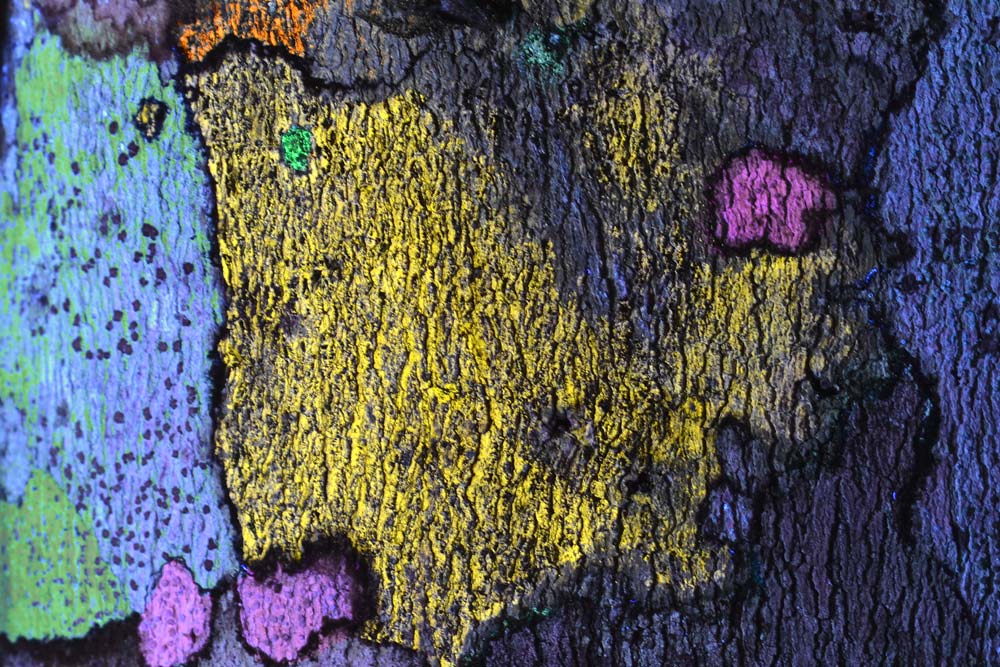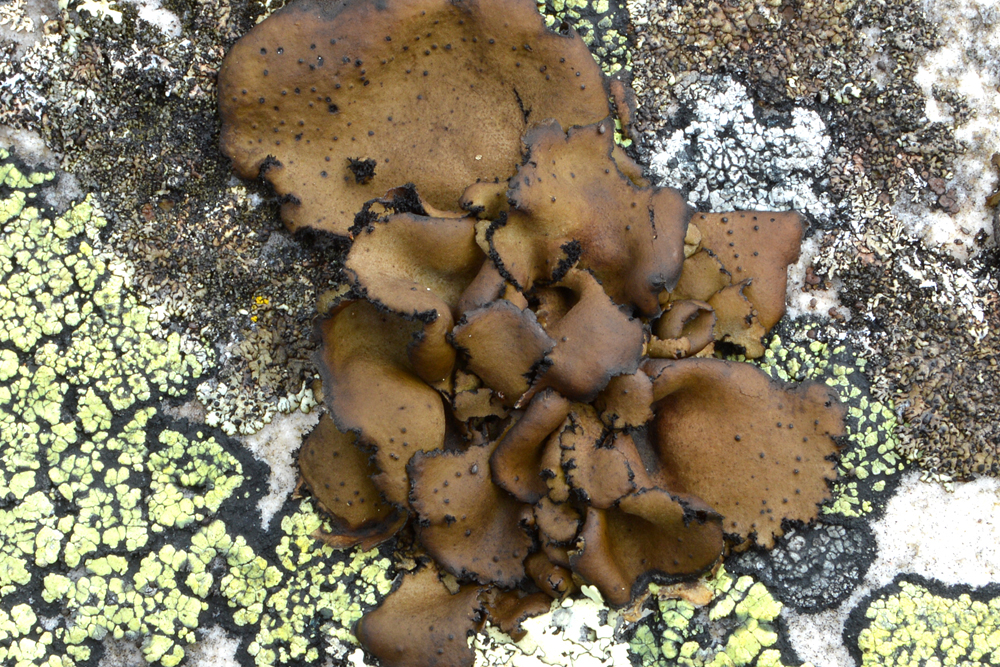What Are Lichens?

A lichen, or lichenized fungus, is actually two organisms functioning as a single, stable unit. Lichens comprise a fungus living in a symbiotic relationship with an alga or cyanobacterium (or both in some instances). There are about 17,000 species of lichen worldwide.
Why form a dual organism?
Fungi are incapable of photosynthesis because they lack the green pigment chlorophyll. That is to say, fungi cannot harvest light energy from the sun and generate their own nourishment in the form of carbohydrates. Instead, they need to seek out outside sources of food. They absorb nutrition from organic substances, that is, carbon containing compounds such as carbohydrates, fats, or proteins.
On the other hand, algae and cyanobacteria can conduct photosynthesis, similar to plants. In fact, chloroplasts, which are the site of photosynthesis in land plants, are adapted forms of cyanobacteria. (These early cyanobacteria were engulfed by primitive plants cells sometime in the late Proterozoic, or in the early Cambrian period, according to the University of California Museum of Paleontology.)
So when a fungus, which is the dominant partner in this relationship, associates with an alga (usually from the green algae) or cyanobacterium to form a lichen, it is providing itself with constant access to a source of nourishment. The fungus controls the association in a way that one could consider as agriculture, said Robert Lücking, curator at the Botanical Garden and Botanical Museum in Berlin, Germany, and research associate at the Integrative Research Center at the Field Museum in Chicago. He described it as the controlled growth of a carbon-providing organism, just like we grow wheat, rice or potatoes. He added that cyanobacteria also provide fungi with the additional benefit of nitrogen fixation. This is the biochemical reaction wherein atmospheric nitrogen is converted to ammonia, a more usable form of the element. In return, algae and cyanobacteria secure a protected environment, especially from damaging ultraviolet rays. Fungi often form a protective cortex [or shell] with pigments that absorb ultraviolet light, Lücking said.
Finally, as lichens, fungi, algae and cyanobacteria are able to live in environments that they could not live in otherwise. Lücking noted that hot and cold deserts, as well as exposed surfaces, are good examples of such environments. [Gallery: Weird World of Lichen: Anything But Ordinary]
Nomenclature
The fungal component of a lichen is known as the "mycobiont," and the algal or cyanobacterial component is known as the “photobiont.” The scientific name for a lichen is the same as that of the mycobiont, regardless of the identity of the photobiont. On his website dedicated to lichen, Alan Silverside, now retired from the University of the West of Scotland, gives the example of the fungus Sticta canariensis. This fungus is capable of forming two different lichen associations with an alga and cyanobacterium, yet both lichens are referred to as Sticta canariensis. “If the fungus species remains the same, then so does the name of the lichen, even if the lichen appearance varies,” Silverside states.

Structure
The vegetative portion of a lichen, known as the thallus, is unknown in non-lichenized fungi, according to Lücking. It is the thallus that gives lichens their characteristic outer appearance. Lichen thalli come in many different forms. Examples on Silverside's pages include foliose lichen, which look flat and leafy; fruticose lichen, which have a wiry, tufted appearance; squamulose lichen, which have flat, overlapping scales; and crustose lichen, which as the name suggests, form a tightly attached crust over the surface it inhabits.
In general, the inside of the lichen thallus appears stratified, with the mycobiont and photobiont cells arranged in layers. According to the U.S. Forest Service, the outer layer or cortex is made up of thick, tightly packed fungal cells. This is followed by a segment with the photobiont (either green algae or cyanobacteria). If a lichen has both an algal and a cyanobacterial partner, the cyanobacteria can be seen within little compartments above the upper cortex. The final layer is the medulla, with loosely arranged fungal cells that look like filaments.
Extensions below the medulla, which are called basal attachments, enable lichens to adhere to various surfaces. Typical basal attachments include rhizines, which are fungal filaments extending from the medulla, and a single, central structure called the holdfast, which latches onto rocks. The Forest Service gives the example of a foliose lichen called the umbilicate lichen, where the holdfast resembles an umbilical cord.
As an exception to the general thallus structure, jelly lichens do not have a layered or stratified thallus. The mycobiont and photobiont components sit together in a single layer. As a result, jelly lichens look like jelly; for example, Collema auriforme.
Appearance
When dry, lichens simply take on the color of the mycobiont (the fungus) itself or can be drab and gray. But when wet, they are completely transformed. This is because the fungal cells in the upper cortex become transparent and the colors of the algal or cyanobacterial layers can shine through. Green algae bestow lichens with a bright green color, while cyanobacteria give hues of dark green, brown, or black, according to the Forest Service.
![Photosymbiodeme with green [algal] lobes growing from cyanobacterial ones.](https://cdn.mos.cms.futurecdn.net/cxewq3vS7DqAzwi5SCLT44.jpg)
Understanding the dynamic
For the mycobiont, the association with the photobiont is “obligate,” or one of dependence. “As far as it is known, the mycobiont cannot persist in nature without lichenization,” Lücking told LiveScience. “The mycobiont is by itself [for] only a brief period when it disperses using fungal spores.”
In order to create and maintain a stable association, evolution has selected for certain characteristics within the lichen partnership. “There are three important factors for the establishment of lichens: recognition, acceptance and fitness of the association,” Lücking said. “All three are assumed to undergo evolutionary selection and hence are being optimized.”
Lücking elaborated on the concept of recognition by pointing out that the mycobiont (fungus) cannot just associate with any given alga or cyanobacterium. It actively seeks out the photobiont by chemical recognition. Acceptance occurs when the two lichen partners interact without negatively influencing one another. “For instance, if the alga considers the fungus a parasite, it will react with defense mechanisms that could prevent the establishment of a stable symbiosis,” he said. “So in evolutionary terms, the two bionts have 'learned' how to interact mutually, but in a way that the fungus controls the interaction.” Finally, the fitness of the relationship is determined by healthy growth and reproductive success. “The more carbohydrates the photobiont can produce per time unit under given conditions, the faster the lichen will grow and the more competitive it is,” Lücking said. He notes that fitness and how the lichen partners work together are dependent on environmental conditions.
Usually, once a lichen association has been established the mycobiont does not switch partners. However, as an exception, Lücking gives the example of Sticta canariensis, a photosymbiodeme (a fungus that can form separate lichens with different photobionts). In this case the fungus associates with a cyanobacterium in shady, humid conditions to form small, shrub-like thalli. However in drier or more exposed conditions, the fungus associates instead with green algae to form large, flat lobes. “When conditions change over time or within a short distance, you see some individuals starting out as cyanobacterial lichens and then suddenly forming green lobes [by associating with green algae],” he said. “So the same fungal individual can switch partners ad hoc.”
What isn’t a lichen?
It’s important to remember that any association between a fungus and alga or cyanobacterium doesn’t automatically count as lichenization. “In lichen associations, the fungus is able to form structures unknown in non-lichenized fungi — the thallus — and the fungus also affects and changes the morphology of the photobiont,” Lücking told LiveScience. “Hence, fungus-algal associations in which this is not the case are not considered lichens.” He added that it is also suspected that certain non-photosynthetic bacteria are important for lichenization.
Mosses are also not lichens, according to the Forest Service. Though at first glance some may superficially resemble a lichen, mosses are actually primitive versions of plants and are capable of independent photosynthesis.
Importance
Lichens are key players in a variety of environmental processes. For example, cyanobacterial photobionts participate in nitrogen fixation. Lichens also contribute to a phenomenon known as biological weathering. The lichen mycobionts can break down rocks and release minerals by producing certain chemicals. Lichens can also disrupt rock surfaces simply by physically attaching to them, and by the expansion and contraction of their thalli, according to a 2000 article published in the journal Catena.
Weathering can lead to the eventual disintegration of rocks, according to the article. While this is a disadvantage, especially when lichens grow on building stones, it is also an essential step for the formation of primitive soils. When lichens decompose, the organic matter that is left behind, along with particles of rock and dust trapped by thalli provide material for the development of primitive soils.
The lichen species Cladonia rangiferina, commonly called reindeer lichen, are an important source of winter forage for most North American caribou populations and key components of a winter diet (except in areas with shallow snow cover or that have mild winters) according to the Forest Service.
Finally, lichens are excellent indicators of pollution. According to the Forest Service lichens can absorb pollutants such as heavy metals, carbon and sulfur into their thalli. Extracting these pollutants gives an indication of the levels present in the atmosphere. This process is known as lichen biomonitoring.
Sign up for the Live Science daily newsletter now
Get the world’s most fascinating discoveries delivered straight to your inbox.
Aparna Vidyasagar is a freelance science journalist who specializes in health and life sciences. Aparna has written for a number of publications, including New Scientist, Science, PBS SoCal, Mental Floss, and several others. Aparna has a doctorate in Cellular and Molecular Pathology from the University of Wisconsin-Madison, and also received a master’s degree and bachelor’s degree from the same university.










